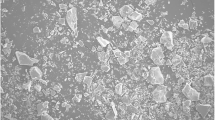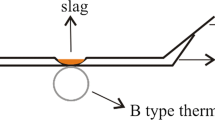Abstract
The low-temperature soda roasting method is an emerging method for the extraction of boron from boron-rich blast furnace slag (BRBFS). The effect of the slag composition on the phase changes and boron water leaching rate during the low-temperature soda roasting process of BRBFS is studied in this paper, providing a theoretical basis for the development and adoption of this method. The effects of the mass percentages of Al2O3, CaO, and B2O3 and R (the mass ratio of MgO to SiO2) on the boron water leaching rate were investigated. The phase changes of BRBFS during the low-temperature soda roasting process were studied via X-ray diffraction analysis. The results demonstrate that the water leaching rate of boron increases with increasing Al2O3 content, and the boron-containing compounds precipitate as Ca3B2O6 and NaBO2 in the Na2CO3-modified slag (NMS); NaBO2 was found to be the primary product. With the increase in CaO content, the overall water leaching rate of boron was found to increase. It was found that the relatively high CaO content in BRBFS promoted the presence of boron in the boron-containing amorphous glass phase and ultimately increased the water leaching rate of boron. As the R value increased, it was found that the water leaching rate of boron decreased, and the generated sodium borate phase changes from Na3BO3 to NaBO2. The Ca3B2O6 in NMS can be considered as being composed of two parts: one is that present in BRBFS before roasting, and the other is that generated during the roasting process. With increasing B2O3 content, the water leaching rate of boron initially shows a slight increase before decreasing, and the sodium borate generated transforms from NaBO2 to Na10B4O11 in NMS.
Graphical Abstract














Similar content being viewed by others
References
Tang Y, Chen CL, Xiong XX, Gao P (2013) World boron distribution and current status of its exploitation and development. Mod Chem Ind 33(10):1–4. https://doi.org/10.16606/j.cnki.issn0253-4320.2013.10.001
Wang G, Wang JS, Xue QG (2018) Properties of boron-rich blast furnace slag separated from boron-bearing iron concentrate. J Cent South Univ 25:783–794. https://doi.org/10.1007/s11771-018-3783-y
Dong MG, Zhou SY, Ge CC, Yang H, Liu M, Lakshminarayana G, Xue XX (2023) Green and low-carbon upcycling of ludwigite: Prepared shields against nuclear radiation hazards and shielding mechanism. Radiat Phys Chem 208:110931. https://doi.org/10.1016/j.radphyschem.2023.110931
Wang G, Xue QG, Wang JS (2016) Effect of Na2CO3 on reduction and melting separation of ludwigite/coal composite pellet and property of boron-rich slag. Trans Nonferr Metal Soc 26(1):282–293. https://doi.org/10.1016/S1003-6326(16)64116-X
Jiang T, Wu JB, Xue XX, Duan PN, Chu MS (2012) Carbothermal formation and microstrutural evolution of α′-Sialon–AlN–BN powders from boron-rich blast furnace slag. Adv Powder Technol 23(3):406–413. https://doi.org/10.1016/j.apt.2011.05.009
Li ZH (2017) Fundamentals for flotation separation of ascharite from serpentine and magnetite. Dissertation, Northeastern University. (in Chinese)
Ye L, Peng ZW, Tian R, Tang HM, Zhang J, Rao MJ, Li GH (2022) A novel process for highly efficient separation of boron and iron from ludwigite ore based on low-temperature microwave roasting. Powder Technol. https://doi.org/10.1016/j.powtec.2022.117848
You JX, Wang J, Luo J, Peng ZW, Rao MJ, Li GH (2022) A facile route to the value-added utilization of ludwigite ore: boron extraction and MxMg1-xFe2O4 spinel ferrites preparation. J Clean Prod 375:134206. https://doi.org/10.1016/j.jclepro.2022.134206
Wei XC, Qy Z, Li XL, Zhang TA (2021) Study on the intensification of the boron-rich slag subsection cooling process. JOM 73:781–790. https://doi.org/10.1007/s11837-020-04546-1
Wang G, Wang JS, Yu XY, Shen YF, Zuo HB (2016) Xue QG (2016) Innovative method for boron extraction from iron ore containing boron. Int J Min Met Mater 23:247–256. https://doi.org/10.1007/s12613-016-1233-0
Jiang T, Xue XX (2012) Synthesis of (Ca, Mg)–α′-Sialon–AlN–BN powders from boron-rich blast furnace slag by microwave carbothermal reduction-nitridation. T Nonferr Metal Soc 22(12):2984–2990. https://doi.org/10.1016/S1003-6326(11)61560-4
Liu SL, Chen J, Zhang XP (1996) Study on leaching boron-rich slag with H2SO4. J Northeastern Univ 17(4):378–380
Li J, Guo XD, Guang M, Jiang T (2014) Preparation of boric acid and magnesium sulfate monohydrate from boron-rich slag by sulfuric acid leaching method. Chin J Nonferrous Met 24(11):2943–2950. https://doi.org/10.19476/j.ysxb.1004.0609.2014.11.034
Chen J, Liu SL, Zhang XP (1996) Study of carbonate-alkaline leaching boron-rich slag for borax preparation. J Northeastern Univ 5:50–53
He D (2010) Study on activity-roasting of boron-rich slag and boron concentrate. Dissertation, Dalian University of Technology. (in Chinese)
Li J, Fan ZG (2011) Experimental study on preparation of borax from boron-rich slag by adding sodium carbonate. Mater Sci Tech-lond 19(1):144–148 ((in Chinese))
Li J, Fan ZG (2009) Study on influencing factors on preparing process of borax from boron-rich slag. J Northeastern Univ 30(12):1755–1758
HG/T 2956.3–2001 (2002) Ascharite ores-Determination of boric anhydride content-Volumetric method. Chemical Industry Standards of the China, China National Economic and Trade Commission.
Li J, Guang M (2019) Preparation of borax from blast furnace boron-rich slag by low temperature sodium roasting and leaching. Ind Miner Process 9:66–70 ((in Chinese))
Ren QQ (2018) Study on crystallization behavior of modified blast furnace molten slag. Dissertation, Northeastern University. (in Chinese)
Esfahani S, Barati M (2016) Effect of slag composition on the crystallization of synthetic CaO–SiO2–Al2O3–MgO slags: Part I-Crystallization behavior. J Non-cryst Solids 436:35–43. https://doi.org/10.1016/j.jnoncrysol.2015.12.011
Xuan WW, Zhang JS, Xia DH (2018) The influence of MgO on the crystallization characteristics of synthetic coal slags. Fuel 222:523–528. https://doi.org/10.1016/j.fuel.2018.02.197
Qin Y, Lv X, Zhang J (2017) Effect of composition on the crystallisation behaviour of blast furnace slag using single hot thermocouple technique. Ironmak Steelmak 44(1):23–27. https://doi.org/10.1080/03019233.2016.1242309
Yang Q, Li J, Li HX, Zhang FX (2001) Study on isothermal solubility for the ternary system Na2B4O7-NaHCO3-H2O and Na2CO3-NaBO2-H2O. J Salt Lake Res 9(4):24–29 ((in Chinese))
You JX, Wang J, Zhang SH, Luo J, Peng ZW, Rao MJ, Li GH (2022) Thermodynamic properties of Na2MgSiO4: DFT calculation and experimental validation. Calphad 79:102480. https://doi.org/10.1016/j.calphad.2022.102480
Dean JA (1991) Lange’s handbook of chemistry, 13th edn. Science Press, Beijing
Ganesh I (2013) A review on magnesium aluminate (MgAl2O4) spinel: synthesis, processing and applications. Int Mater Rev 58(2):63–112. https://doi.org/10.1179/1743280412Y.0000000001
Buscaglia V, Delfrate MA, Leoni M, Bottino C, Nanni P (1996) The effect of MgAl2O4 on the formation kinetics of Al2TiO5 from Al2O3 and TiO2 fine powders. J Mater Sci 31:1715–1724. https://doi.org/10.1007/BF00372183
Luo XF, Ren LC, Xie WT, Qian L, Wang YZ, Sun QL, Zhou HQ (2016) Microstructure, sintering and properties of CaO–Al2O3–B2O3–SiO2 glass/Al2O3 composites with different CaO contents. J Mater Sci-Mater El 27:5446–5451. https://doi.org/10.1007/s10854-016-4448-y
Bulutcu AN, Baloglu H (2022) Eutectic temperature, density, and dolubility of H3BO3-H2O, Na2B4O7-H2O, and NaBO2-H2O binary systems. J Chem Eng Data 67(9):2149–2159. https://doi.org/10.1021/acs.jced.2c00124
Ye DL, Hu JH (2002) Handbook of thermodynamic data of inorganic compounds. Metallurgical Industry Press, Beijing
Acknowledgements
The research leading to these results has received funding from the National Natural Science Foundation of China (Grant No. 52064041) and the Basic Scientific Research Business Cost Project of Universities Directly under the Inner Mongolia Autonomous Region (Grant No. JY20220065).
Author information
Authors and Affiliations
Corresponding authors
Ethics declarations
Conflict of interest
On behalf of all authors, the corresponding author states that there is no conflict of interest.
Additional information
The contributing editor for this article was Sharif Jahanshahi.
Publisher's Note
Springer Nature remains neutral with regard to jurisdictional claims in published maps and institutional affiliations.
Rights and permissions
Springer Nature or its licensor (e.g. a society or other partner) holds exclusive rights to this article under a publishing agreement with the author(s) or other rightsholder(s); author self-archiving of the accepted manuscript version of this article is solely governed by the terms of such publishing agreement and applicable law.
About this article
Cite this article
Li, J., Guang, M. & Lu, Y. Effect of Composition on Low-Temperature Soda Roasting of Boron-Rich Blast Furnace Slag. J. Sustain. Metall. 9, 1215–1225 (2023). https://doi.org/10.1007/s40831-023-00725-x
Received:
Accepted:
Published:
Issue Date:
DOI: https://doi.org/10.1007/s40831-023-00725-x




